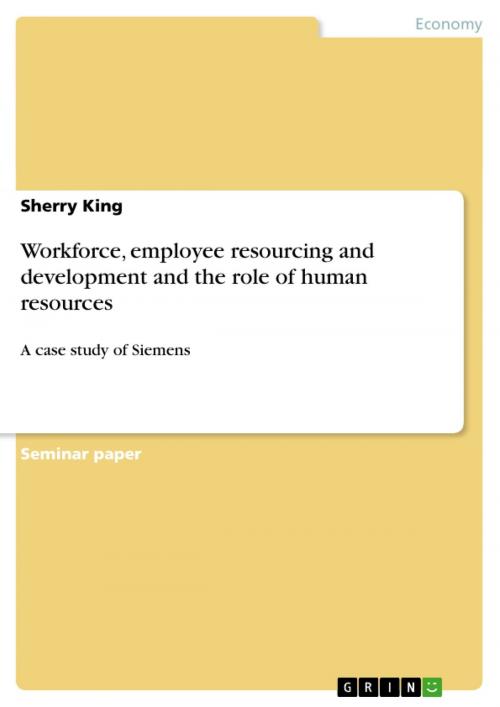Workforce, employee resourcing and development and the role of human resources
A case study of Siemens
Business & Finance, Human Resources & Personnel Management| Author: | Sherry King | ISBN: | 9783656611547 |
| Publisher: | GRIN Verlag | Publication: | March 7, 2014 |
| Imprint: | GRIN Verlag | Language: | English |
| Author: | Sherry King |
| ISBN: | 9783656611547 |
| Publisher: | GRIN Verlag |
| Publication: | March 7, 2014 |
| Imprint: | GRIN Verlag |
| Language: | English |
Seminar paper from the year 2014 in the subject Business economics - Personnel and Organisation, grade: A, King`s College London, language: English, abstract: In the earlier times, only cash, shares etc. were considered the 'capital' for the organization. But with the changing times, the organizations have realized that 'people' are its most important resource and they belong to what we term as 'capital'. Organizations have realized that besides the physical resources (Physical resources are tangible items that the organization uses to get its work done, such as laptops, stationery, printing machines, cooking supplies, mobiles, internet connection etc.) and financial resources (such as allotted funds for various expenditures and budgets fixed and made available to the organization), an organization also has resources which compliment the organization behavior; resources like knowledge, ability, skills acquired decision-making and intelligence of the employees. Because of the value that people add in the organization, it is essential that organizations realize their importance and take measures to ensure that the needs and expectations of their workforce are fulfilled, regardless of their contribution or the nature of their job. The people who are the resources acting behind the scene, working and contributing to the organization, are the most valuable resources that a company possess and can utilize to create a competitive advantage for themselves. (Vleet, 2011) Siemens believe that the people who have the spark to make a difference and do something in life, they are always welcomed and are trained and developed. At Siemens, they have various training and development programs, they value people a lot. Siemens basically believes that their company is run by its employees and they must be taken utmost care of. Siemens also sharpens the skills of the people from time to time so that to ensure continuous employ ee development keeps going on and on.
Seminar paper from the year 2014 in the subject Business economics - Personnel and Organisation, grade: A, King`s College London, language: English, abstract: In the earlier times, only cash, shares etc. were considered the 'capital' for the organization. But with the changing times, the organizations have realized that 'people' are its most important resource and they belong to what we term as 'capital'. Organizations have realized that besides the physical resources (Physical resources are tangible items that the organization uses to get its work done, such as laptops, stationery, printing machines, cooking supplies, mobiles, internet connection etc.) and financial resources (such as allotted funds for various expenditures and budgets fixed and made available to the organization), an organization also has resources which compliment the organization behavior; resources like knowledge, ability, skills acquired decision-making and intelligence of the employees. Because of the value that people add in the organization, it is essential that organizations realize their importance and take measures to ensure that the needs and expectations of their workforce are fulfilled, regardless of their contribution or the nature of their job. The people who are the resources acting behind the scene, working and contributing to the organization, are the most valuable resources that a company possess and can utilize to create a competitive advantage for themselves. (Vleet, 2011) Siemens believe that the people who have the spark to make a difference and do something in life, they are always welcomed and are trained and developed. At Siemens, they have various training and development programs, they value people a lot. Siemens basically believes that their company is run by its employees and they must be taken utmost care of. Siemens also sharpens the skills of the people from time to time so that to ensure continuous employ ee development keeps going on and on.















